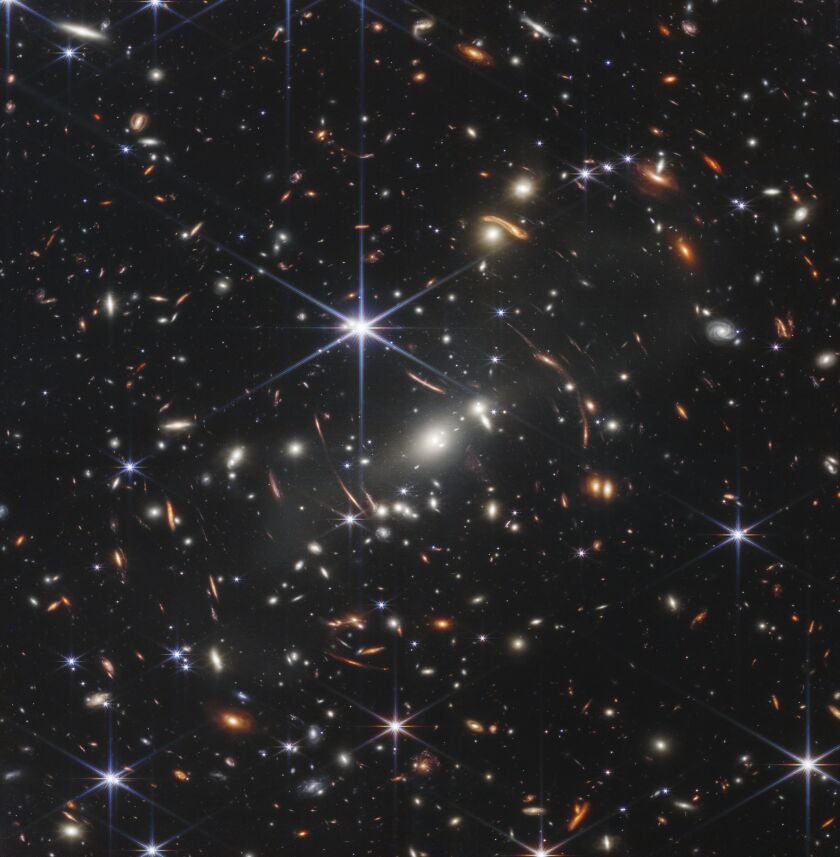It’s impossible, really, to look at the stunning new images unveiled last week from the James Webb Space Telescope and not imagine: What’s out there?
What’s out there, amid the swirling gas clouds and pinpoints of light we can now see in full color, originating from billions of light-years out in space?
What’s out there, in those other galaxies far, far away?
And how did what’s out there — and maybe, who’s out there — come to be, all those billions of years ago after the Big Bang?
Even non-astronomers can appreciate the astonishing beauty of the images NASA rolled out to the public last Tuesday, a day after President Joe Biden gave the nation a sneak peak of the very first photo showing a galaxy cluster called SMACS 0723.
“We can see possibilities no one has ever seen before,” Biden said, and you could almost hear the theme music from the original Star Trek swelling in the background as he spoke. “We can go places no one has ever gone before.”
“These images, including the deepest infrared view of our universe that has ever been taken, show us how Webb will help to uncover the answers to questions we don’t even yet know to ask,” NASA Administrator Bill Nelson said in a statement. “Questions that will help us better understand our universe and humanity’s place within it.”
Take a moment to look at the images ( at https://www.nasa.gov/webbfirstimages ) and anticipate more to come. They’re worth celebrating in their own right, and as a welcome antidote to the relentless bad news we hear every day about gun violence, rising inflation, BA.5, government corruption and more.
We ought to celebrate, too, the hard work of every scientist, engineer and technician who was involved in designing, building and launching Webb so that these images could be possible. That the Webb telescope made its million-mile journey to successfully orbit our sun — in working order — is a testament to what’s possible through science.
Want an idea of the telescope’s complexity? Its primary mirror has 18 separate segments that had to unfold and adjust, automatically, after the telescope’s launch. Its sunshield is the size of a tennis court, made up of five layers of material that have to reduce the heat from the sun — remember, the telescope orbits the sun — a million times.
No wonder Jane Rigby, NASA’s operations project scientist, recalled Tuesday what she said to herself upon seeing the first images: “I had the very emotional reaction of ‘Oh my goodness, it works.’ And it works better than we thought.”
There’s a lesson in that for every science-denier out there.
“The telescope works, and it works brilliantly,” University of Chicago astronomy professor Jacob Bean told the Sun-Times’ Mitch Dudek last week. “Our knowledge about the universe is about to take a giant leap forward.”
A place in line for Chicago scientists
Bean is one of several Chicago-area scientists who have been awarded time to use Webb for their research projects. Bean is a co-leader of a team of about 150 scientists who are studying exoplanets — planets that orbit stars outside of our own solar system.
Their goal: to look for clues about the composition of these exoplanets, how cold or warm they are, and whether they are habitable.
“Theoretical calculations suggest that there are around 300 million potentially habitable planets in the Milky Way galaxy alone and several habitable Earth-sized planets within only 30 light-years of Earth — essentially humanity’s galactic neighbors,” as University of Arizona astronomy professors Chris Impey and Daniel Apai wrote in a recent essay “So far, astronomers have discovered over 5,000 exoplanets, including hundreds of potentially habitable ones.”
Webb wasn’t designed specifically to search for signs of life elsewhere in the universe, but it is able to scrutinize a few of the nearest potentially habitable worlds, as Impey and Apai explain. Future powerful telescopes will be better able to detect biosignatures that are a sign of potential life.
Thanks to Webb, scientists will be able to tell us far more about the universe and how it came into being.
And maybe put us a small step closer to finally answering the biggest question of all: Are we alone?
The Sun-Times welcomes letters to the editor and op-eds. See our guidelines.






